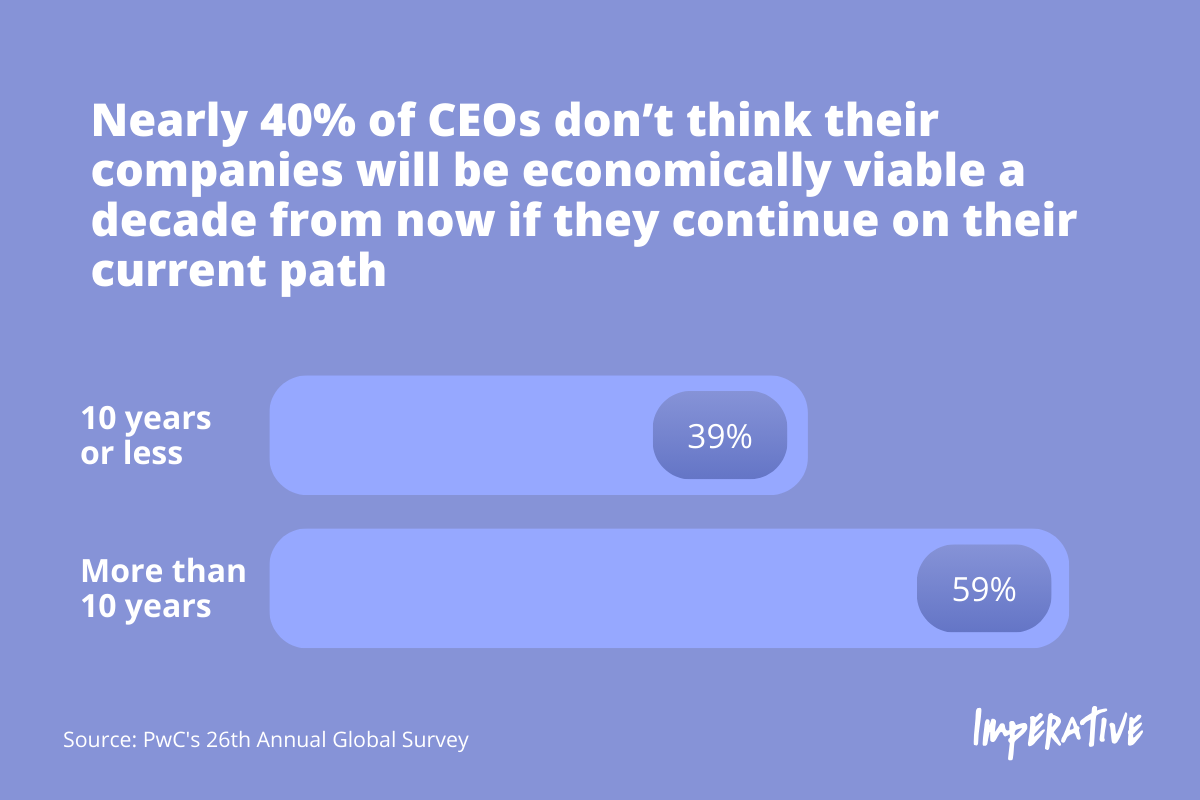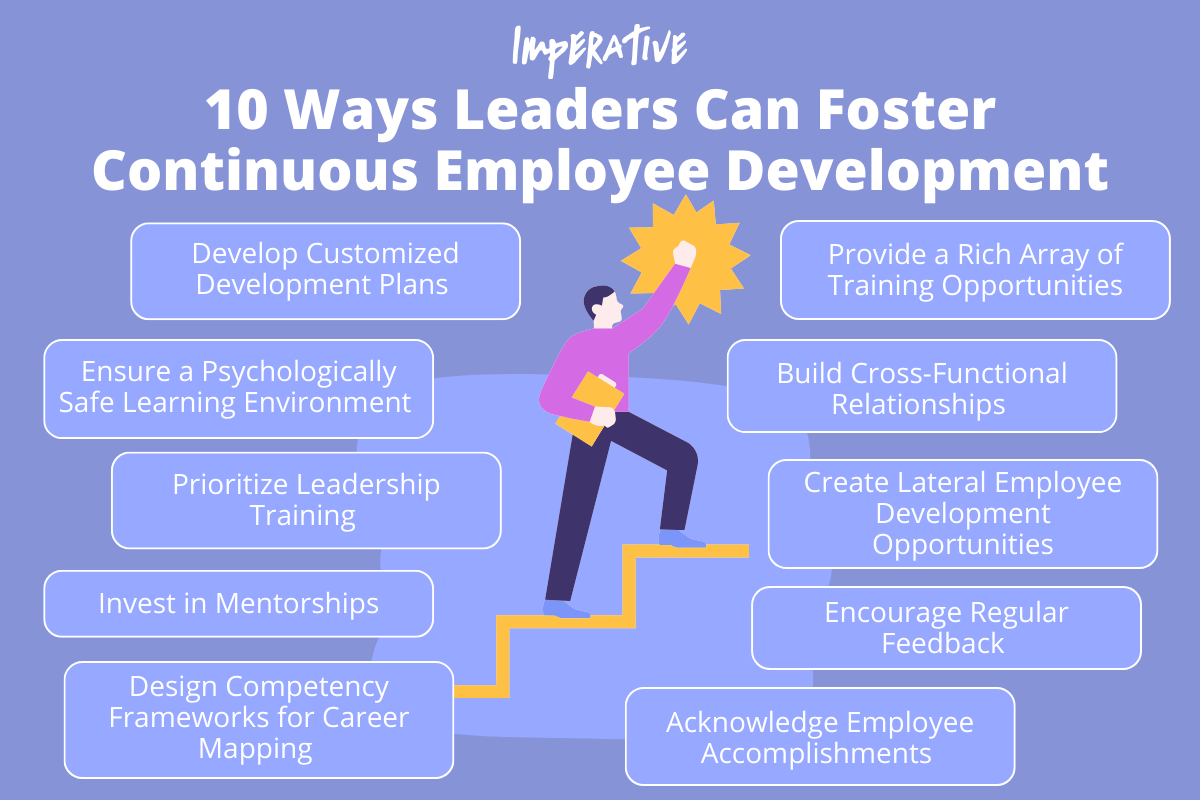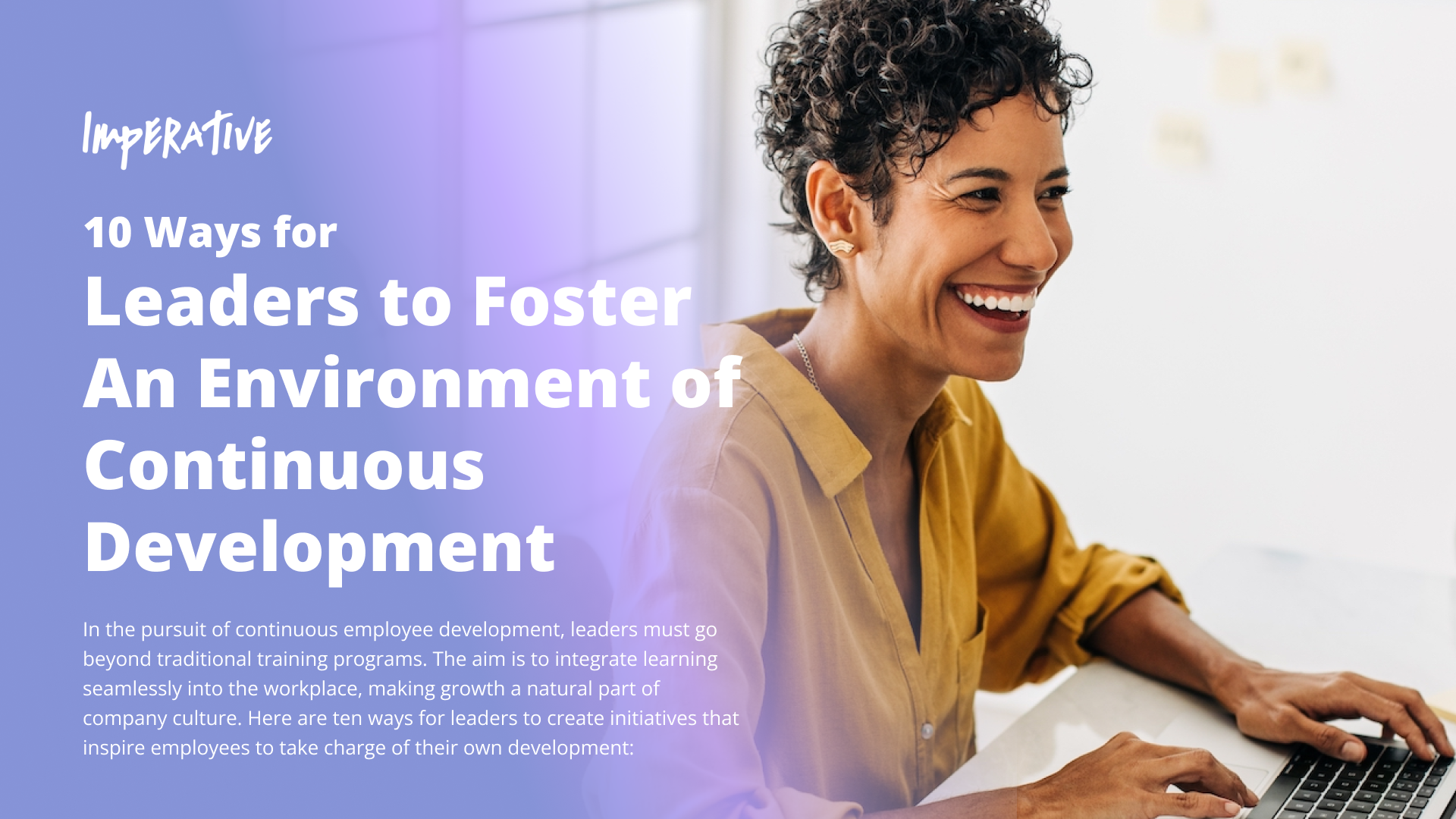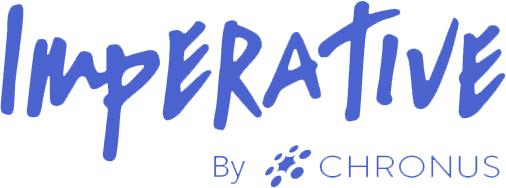Employee Development for Leaders:
10 Ways to Empower Employees to Own Their Professional Growth
What This Article Covers:
Only 35% of learners were encouraged to learn by their managers in the past six months. This statistic serves as a reminder of the critical role leaders play in fostering employee development. But it’s a role that is overlooked in almost two-thirds of organizations.
In our article, we explore how leaders can empower employees to take ownership of their professional growth. You’ll gain insights into why employee development matters and discover ten actionable strategies to create a culture of continuous learning.
Whose Responsibility is Employee Development?
Employee development programs are pivotal for organizational success. By elevating employees’ current skills and capabilities, companies experience reduced turnover rates, improved job satisfaction, and the ability to expand with a skilled workforce.
But the path to effective employee development isn’t always clear-cut. The concept of employee development as an umbrella term for numerous types of training, mentoring, and upskilling initiatives can be vague. And in some companies, it’s unclear who should drive development or what it entails. Traditionally, there have been two options:
1. Leaders Take Charge of Employee Development Plans
In this scenario, leaders may prescribe employee training programs based on organizational needs.
Example: A company’s professional skills audit reveals that no one in the organization possesses artificial intelligence engineering experience. To combat this, leaders require all technical employees in the engineering department to complete an artificial intelligence training program, regardless of their personal interest in this area. Leaders will select the course and cover training costs, and employees must complete it within a given timeframe.
2. Leaders Take a Hands-off Approach to Employee Development
Leaders leave training decisions down to the individual employees. They might offer a budget or ask workers to research additional training they could complete to further their careers. But there’s no real plan to integrate continuous development in company culture.
Example: Maria is excited to start with a new company after the talent acquisition team promises her rich growth and development opportunities. Speaking to her new manager, she understands that the onus is on her to figure out what training she would like to participate in, and then she can submit the course options and costs for approval. Maria doesn’t quite achieve the professional growth she’d anticipated. Her manager doesn’t take an active role in Maria’s development, and also fails to provide adequate time to allow her to complete training alongside her workload.
Neither option is perfect, but a third approach emerges that could unlock tremendous opportunities in your organization.
3. Leaders Empower Employees to Take Ownership of Their Professional Growth
Leaders hold regular development conversations with employees, carve out dedicated time for training, and provide access to tools and resources (including themselves). By doing so, they support their employees in building a growth mindset and actively shaping their own career paths.
Example: Wayne is an employee with a strong interest in emerging technologies. His manager encourages him to explore his passions and identifies potential growth areas in the programming language F#. Wayne receives dedicated time for training, access to relevant resources, and regular development conversations. With his manager’s guidance, Wayne crafts a career development plan that includes online F# courses, participation in industry webinars, and even a small F#-related project within his team. This approach enhances Wayne’s skills and aligns his interests with the company’s strategic direction. Best of all, Wayne doesn’t need to switch companies to further his career.
However, this approach isn’t without its challenges. Author, speaker, and consultant Julie Winkle Giuloni has witnessed a recent lapse in employees holding themselves accountable for their own career progression. In an article for HR.com, she outlines that the rise of employee burnout, anxiety, and confusion about their future careers may all cause workers to take a step back from accelerating their professional development. She said,
“As I talk with managers and leaders, I’m hearing a disturbing trend. While employees may express a desire to develop their careers, they may be taking a less active role in making it happen.”
Strategy Facilitator Alex Brueckmann believes the responsibility lies with leaders to motivate their employees to own their development journeys. It’s about going back to basics and setting a good example.
“In larger organizations, I’ve been observing a development fatigue when leaders don’t walk the talk. It’s a bit like in parenting: when kids want to do sports because they see how their parents enjoy being physically active. A couch potato rarely raises an Olympian.”
Why Should Leaders Care About Employee Development?
It’s intuitive to see what employees have to gain from their professional development. LinkedIn highlights some of the top motivations that employees have to learn:
- Progressing toward their career goals
- Staying up to date in their fields
- Personalizing learning to suit their own interests and long-term goals
But there are also tangible benefits for leaders who commit to developing their employees, at all ranks and in all roles.
1. Improving Retention
In the aftermath of the Great Resignation and quiet quitting, companies are still understandably nervous about holding onto staff with itchy feet. LinkedIn highlights that 93% of organizations are concerned about employee retention, and their top strategy to retain workers is “providing learning opportunities.”
2. Closing Skill Gaps
The working world is changing rapidly, with new priorities like artificial intelligence, sustainability, and regulatory change requiring limitless skills to keep up with the disruption. The Workplace Learning Report finds that skill sets for jobs have already shapeshifted by 25% since 2015. We can expect this number to double by 2027, meaning that only half of the daily skills in a given role will still be relevant in four years.
This is anxiety-provoking for both organizations and employees alike. Now is not the time to sit back and see how the situation pans out. Instead, 89% of L&D pros agree that proactively building employee skills is the best way to prepare for the ever-evolving future of work.
3. Creating Productive Employees
Enhancing individual skills produces high-quality work at a more efficient rate than when skills training is absent. To prove this, the American Society for Training & Development explored how development directly impacts productivity by studying two corporate groups. The group that invested three times as much into training achieved 57% more in sales, and a 37% increase in gross profit per employee compared to the group that invested nothing.
4. Reinventing Their Business For The Future
Here’s a stark data point: 40% of global CEOs don’t believe their organization will be economically viable in ten years.

PwC’s Global CEO survey highlights that upskilling the company’s workforce in priority areas is the second-highest investment area for C-suite execs, with 59% of companies doing so to reinvent their business for the future.
5. Attracting Gen Z and Millennial Workers
With up to five active generations in the current workforce, companies must find ways to appeal to each. While retirement security may appeal to older generations, LinkedIn reports that Gen Z and millennial workers are more likely to value career growth, learning, and skill-building opportunities.
Companies must use every stage of the recruitment process, from headhunting and publishing job ads to interviews, to highlight the breadth of opportunities they can offer employees. Job seekers must visualize what the company could offer them within six months to five years to ensure it aligns with their personal goals.
How Can Leaders Foster An Environment of Continuous Employee Development?
There’s always a case for incorporating traditional training sessions into your development programs. But L&D should be more than a checkbox exercise where leaders send their employees off to complete their annual skills training and don’t think about it again for another year. Instead, continuous employee development happens in the flow of work, ensuring that growth is synonymous with company culture and never something you have to squeeze in alongside a busy workload.
Here are ten ways for leaders to create employee development initiatives that inspire employees to power ahead toward their career goals.
1. Develop Customized Development Plans
Effective career development isn’t one-size-fits-all. Each employee should have an individual employee development plan that is tailored to their specific needs and goals, including some or all of the following:
- Personalized employee goals: Clearly defined short-term and long-term objectives aligned with the employee’s role and career aspirations.
- Skills assessment: Identification of existing strengths and areas for improvement through self-assessment and manager feedback.
- Suggested learning methods: Selection of appropriate learning resources, such as workshops, online courses, on-the-job training, mentoring, or conferences.
- Timeline and milestones: Realistic dates for achieving milestones and goals, ensuring a structured and realistic progression.
- Employee feedback mechanisms: Regular check-ins are scheduled with managers or mentors to review progress and receive feedback.
- Performance metrics: Defined metrics to measure progress and success, such as improved task completion times or increased customer satisfaction scores.
- Stretch tasks and specialist projects: Inclusion of challenging tasks or projects to encourage stepping out of the comfort zone and promoting growth.
- Networking opportunities: Suggestions for networking events, conferences, or workshops to expand professional connections and industry knowledge.
By working through these highly individual details, leaders can take the time to get to know individuals, assess their progress, and suggest resources that align with employee and organizational goals.
2. Ensure a Psychologically Safe Learning Environment
Any type of training or growth requires a learning curve. Employees must feel free to make mistakes, ask questions, and have opportunities to put learning into practice without fear of failure or judgment. Leaders can create a psychologically safe learning environment by:
- Setting clear rules and expectations around respectful behavior, collaboration, and constructive feedback.
- Recognizing that everyone learns at their own pace and is individual in the way they learn best.
- Offering support and guidance to all employees as they try new skills or concepts.
- Encouraging a culture of open dialogue and honest feedback to reduce the fear of failure.
- Allowing employees to shadow colleagues or gain additional coaching from mentors when needed.
- Offering incentives for taking risks and experimenting with new methods, then celebrating them whether they’re successful or not.
By setting up this supportive environment where mistakes are a byproduct of successful growth, leaders empower employees to take ownership of their professional growth and step out of their comfort zones in a safe space.
Example: Software company Menlo Innovations hangs a sign in its office with a reminder to “Make mistakes faster.” As Chief Happiness Officer Alexander Kjerulf puts it, “Mistakes are an integral part of doing anything cool, and interesting and the sooner you can screw up, the sooner you can learn and move on.”
3. Prioritize Leadership Training
The best way to ensure that employees feel supported is to make sure leaders themselves have the training and resources required to develop highly skilled employees. Anyone working in leadership roles must also advertise that they’re actively pursuing their own career development, which sets a great example for employees to follow suit. Leadership development initiatives may include:
- Leadership skills: Teach leaders to work with their direct reports through coaching techniques that focus on listening, questioning, and brainstorming different options.
- Performance management: Train leaders to increase motivation, track performance progress, and deliver effective feedback.
- Communication skills: Provide tools to help leaders understand communication styles and learn how to tailor their approach based on the individual. For example, one employee might prefer to receive written feedback they can review several times to let it soak in, while others thrive from face-to-face interaction.
- Emotional intelligence: Help leaders understand the role of emotions in workplace relationships and create a safe environment for employees to express themselves without judgment.
- Conflict resolution: Teach leaders how to identify, manage, and resolve disagreements in the workplace.
- Strategic planning: Help leaders learn how to set individual goals and objectives that align with overall business goals.
4. Invest in Mentorships
Historically, mentorships have produced excellent results—for example, Apple CEO Steve Jobs mentored Meta’s Mark Zuckerberg. And, according to LinkedIn’s Workplace Learning Report, employee mentorships are another top L&D priority in 2023.
The idea is straightforward. Employees pair with an experienced mentor who provides advice and guidance to help them reach their career goals. Mentorships also encourage peers to learn from one another, build relationships, and network across the organization. Leaders can support this effort by:
- Identifying mentors based on skill level, experience, and interests.
- Setting clear objectives for mentees and mentors.
- Specifying the duration of the program and how often they should meet.
- Using guided conversations to improve employee engagement.
Imperative tip: Use our platform to host these peer or mentorship conversations, enabling employees to connect the dots between their personal strengths and their professional goals.
5. Design Competency Frameworks for Career Mapping
Employees should always understand what options are available to them within an organization. In an equitable company, everyone must be able to progress to any role as long as they demonstrate the necessary skills. Leaders can create this career mobility by establishing competency frameworks to clearly define each role regarding core competencies, responsibilities, and qualifications required. Then, employees can use these frameworks as a roadmap to map out their path. A few ways leaders can establish robust competency frameworks include:
- Creating clear descriptions for each role highlighting what qualities and skills are needed.
- Identifying the desired outcomes to ensure that each role aligns with organizational goals.
- Collaborating with team members and stakeholders to get feedback on each competency framework.
- Making sure job descriptions reflect any changes in roles or qualifications.
- Establishing a clear process for employees to apply, be interviewed, and accepted into new roles.
By designing these career paths, leaders can demonstrate to employees that their growth and development are valued and provide a framework for them to use as they continue to pursue their professional goals and objectives.
6. Provide a Rich Array of Training Opportunities
Leaders should focus on providing multiple forms of employee training, from classroom-style courses and live webinars to podcasts and online communities. This will help all employees find something that resonates with their learning style. For example:
- Kinesthetic learners respond well to hands-on, practical training, including simulations and experiments.
- Auditory learners prefer to listen to podcasts, group discussions, and lectures where communication is a priority.
- Visual learners may benefit from information presented in videos, infographics, and flashcards.
- Reader-writer learners prefer self-paced training using materials like books, articles, or access to learning experience platforms (LXP) and learning management systems (LMS.)
7. Build Cross-Functional Relationships
To create a holistic approach to employee development, leaders can collaborate with professionals from various functions, such as talent acquisition, talent management, and diversity, equity, and inclusion (DEI). By baking development into the entire employee experience, leaders can:
- Identify skills needed for future roles and align hiring practices with these skills.
- Collaborate with talent management to create personalized employee growth plans that align with career trajectories.
- Work with DEI teams to ensure that growth opportunities are inclusive and accessible to all employees, fostering diversity in skill sets.
8. Create Lateral Employee Development Opportunities
Horizontal career moves, such as job rotations and secondments, are vital for upskilling and reskilling employees while adding strength and depth to the talent bench. Leaders can emphasize the importance of lateral moves by:
- Encouraging employees to explore different departments or roles to acquire new hard or soft skills while gaining additional perspectives.
- Establishing a clear process for employees to express interest in lateral moves and ensuring equitable selection criteria.
- Highlighting success stories of employees who have benefited from lateral development in terms of skill growth and career advancement.
Example: Laura works in sales but has long harbored an interest in learning more about working in communications. Laura’s manager liaises with a fellow leader in communications to create a job secondment arrangement for her, allowing her to gain experience in both departments while honing her communication and marketing skills.
9. Encourage Regular Feedback
Regular feedback is a cornerstone of development and something your workers crave. Inc. reports that Gen Z employees are the most demanding of the generations, with 40% expecting daily check-ins with their boss. They understand the value of ongoing, two-way feedback between employees and their managers or peers which can:
- Facilitate continuous improvement by giving employees insights into their performance and growth areas.
- Create an environment where employees feel valued and supported in their development journey.
- Help employees set meaningful goals and track their progress over time.
Imperative Tip: Our platform is ideal for hosting structured feedback conversations that align with employees’ strengths and development goals.
10. Acknowledge Employee Accomplishments
Recognizing and celebrating employee achievements is a powerful way to reinforce positive learning behavior, with research suggesting that 83.6% of employees feel motivated by recognition in the workplace. Leaders can use rewards and recognition systems effectively by:
- Implementing an employee recognition program that acknowledges milestones, completed projects, and acquired skills.
- Tying recognition to the organization’s core values and strategic objectives to reinforce the importance of skill development.
- Sharing success stories and accomplishments through internal communication channels to inspire other employees.

Prioritize Employee Development with Imperative
It’s impossible to overstate the role of leaders in fostering an environment of continuous employee development. By embracing a proactive approach to development, leaders empower the individuals in their teams to take charge of their professional growth, fostering a culture of innovation, adaptability, and excellence.
At the heart of this employee-led development culture stands Imperative, a powerful solution that aligns seamlessly with the principles highlighted in this guide. Our platform facilitates mentoring relationships, nurtures regular feedback loops, and promotes open communication among team members. By providing a structured environment for employees to explore their strengths, set goals, and seek guidance, Imperative offers a tangible way for leaders seeking to implement a culture of learning.
Ready to create an environment where ambitious employees are motivated to develop and equipped with the tools to succeed? Book a free demo of Imperative today.

